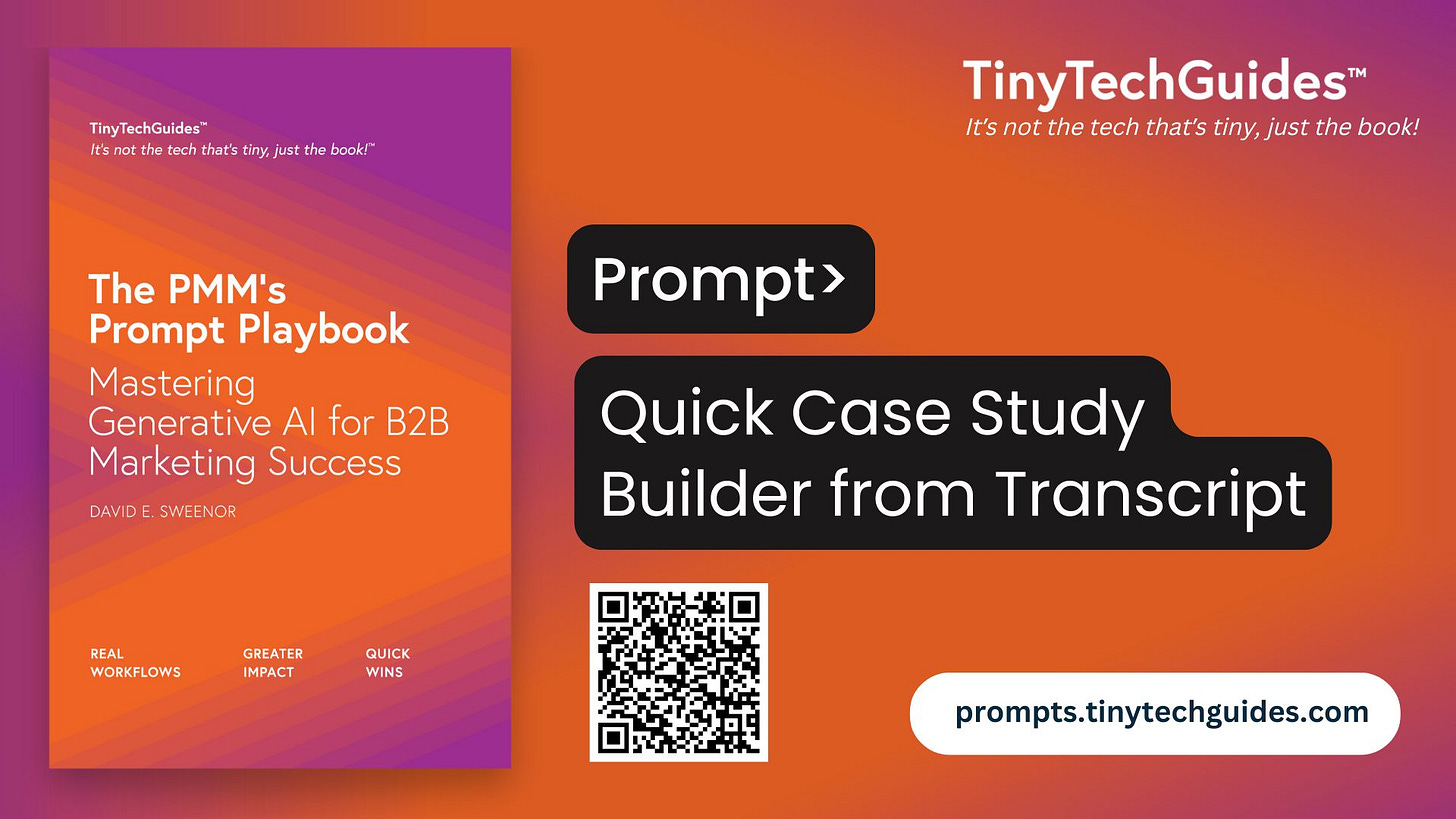Bonus Prompt: Quick Case Study Builder from Transcript with Quotes, Callouts & Outcomes
Content and Communications
This prompt, along with 30 others, is included in The PMM’s Prompt Playbook. These cut-and-paste prompts, along with bonus prompts not in the book, will be made available to paid subscribers on a weekly basis.
Get the PMM’s Prompt Playbook and Modern B2B Marketing today!
What This Workflow Does
This workflow transforms raw interview transcripts into polished B2B case studies by guiding users through a structured process that extracts challenges, solutions, and results. It includes steps to highlight impactful quotes, quantifiable outcomes, and strategic callouts, ensuring the final case study is both compelling and conversion-ready. Designed for marketers, writers, and strategists, it delivers clear, scannable content that resonates with decision-makers.
Workflow Steps Summary
Step 0: Define Inputs
Step 1: Identify Key Elements from the Transcript
Step 2: Summarize the Business Challenge
Step 3: Describe the Solution Implemented
Step 4: Extract Key Quotes and Soundbites
Step 5: Highlight Quantifiable Results and Outcomes
Step 6: Draft Case Study with Callouts and Formatting
Step 0: Define Inputs
{transcript = raw interview or discussion text}{company_name = name of the business featured}{industry = relevant industry/sector}{persona = interviewee’s title or role}{product_or_service = what was used or implemented}{key_metrics = KPIs or outcomes discussed}{tone = tone for the case study (e.g. professional, conversational, bold)}
Step 1: Identify Key Elements from the Transcript
Goal: Break down the transcript into challenge, solution, and result segments.
<Role>You're an experienced B2B content strategist.</Role>
<Context>You’ve received a transcript from a client interview and need to extract the foundational elements for a case study.</Context>
<Task>From the provided {transcript}, extract and label:
1. The primary business challenge
2. The implemented solution
3. The outcomes/results
Label these clearly and group them logically.</Task>
<Format>Use bullet points under headers: Challenge, Solution, Results.</Format>
<Tone>Keep the tone clear and analytical.</Tone>
Step 2: Summarize the Business Challenge
Goal: Turn the raw challenge info into a polished problem statement.
<Role>You're a B2B case study copywriter.</Role>
<Context>You’ve isolated the business challenge from the transcript and need to phrase it as a compelling narrative that sets up the case study.</Context>
<Task>Using the extracted challenge from Step 1, write a short, engaging paragraph that outlines the pain points, stakes, and why solving it mattered to {company_name}.</Task>
<Format>One paragraph, 4–6 sentences, narrative style.</Format>
<Tone>{tone}</Tone>
Step 3: Describe the Solution Implemented
Goal: Summarize what was done using the product or service.
<Role>You're writing the solution section of a case study.</Role>
<Context>The client used {product_or_service} to address their challenge. Pull key actions, features, or methods from the transcript that explain how the solution was used effectively.</Context>
<Task>Craft a summary of how the solution worked, who was involved, and what was unique or strategic about it.</Task>
<Format>2–3 paragraphs, use subheadings if needed (e.g., “Implementation,” “Collaboration”).</Format>
<Tone>{tone}</Tone>
Step 4: Extract Key Quotes and Soundbites
Goal: Pull in powerful, short quotes that bring authenticity.



